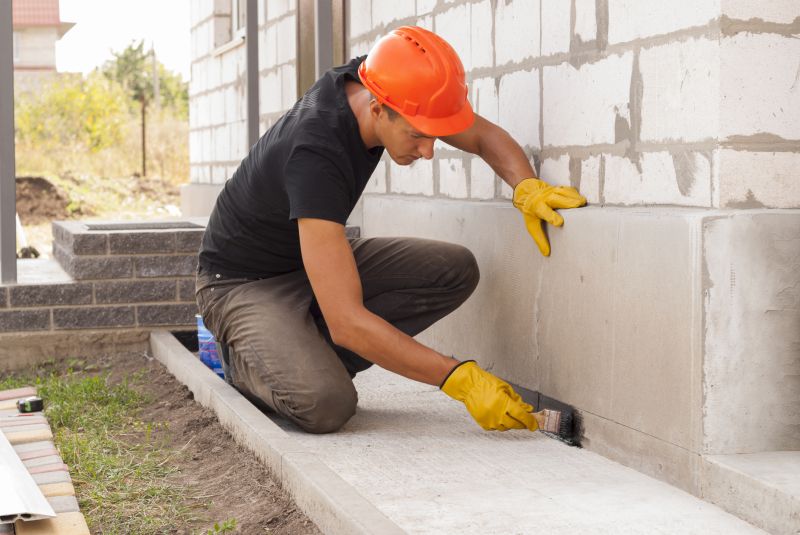Top-Rated Products For Foundation Repair Projects
Review essential tools and materials that make foundation repairs more efficient and effective for homeowners and professionals.
 Foundation repairs are a critical aspect of maintaining the structural integrity of a building, especially in areas like Elk Grove, CA, where soil conditions and weather patterns can influence foundation stability. When considering foundation repair products, it is essential to understand the variety of options available, each designed to address specific issues such as settling, cracking, or shifting. From underpinning systems to stabilization solutions, choosing the right products can help mitigate further damage and support long-term stability.
Foundation repairs are a critical aspect of maintaining the structural integrity of a building, especially in areas like Elk Grove, CA, where soil conditions and weather patterns can influence foundation stability. When considering foundation repair products, it is essential to understand the variety of options available, each designed to address specific issues such as settling, cracking, or shifting. From underpinning systems to stabilization solutions, choosing the right products can help mitigate further damage and support long-term stability.
Top Overall Option
Polyurethane Foam Injection Systems
Polyurethane foam injection systems are versatile and minimally invasive solutions used to lift and stabilize settled or cracked foundations. They can be injected into voids and unstable soils beneath the foundation, providing immediate support and reducing further shifting. These systems are often favored for their quick application and ability to target specific problem areas without extensive excavation. When properly applied, they can help improve foundation stability and prevent water intrusion, making them a popular choice for various foundation repair needs.
Types of Products For Foundation Repairs
Push Piers
Push piers are driven into stable soil beneath the foundation to provide support and lift settling structures.
Helical Piers
Helical piers are screwed into the ground to stabilize and lift foundations, suitable for various soil conditions.
Mudjacking and Slab Jacking
This technique involves injecting a slurry beneath concrete slabs to lift and stabilize sunken areas.
Polyurethane Foam Injection
A quick, minimally invasive method to fill voids and lift settled foundations using expanding foam.
Underpinning Systems
Underpinning involves strengthening existing foundation elements to improve stability and support.
Carbon Fiber Reinforcement
Carbon fiber strips are used to reinforce cracked walls and prevent further movement.
Soil Stabilization Products
These products improve soil conditions around the foundation to reduce shifting and settling.
Drainage and Waterproofing Solutions
Proper drainage and waterproofing help prevent water-related foundation issues.
Anchor Bolts and Braces
Used to stabilize walls and prevent bowing or cracking.
Grout and Epoxy Injections
Injected into cracks to seal leaks and restore structural integrity.
Foundation Repair Anchors
Anchors stabilize bowing or leaning basement walls.
Vapor Barriers and Moisture Control
Help regulate moisture levels to prevent soil expansion and contraction.
Popular Choices
Widely used for quick stabilization of settled slabs and foundation areas.
Commonly selected for lifting and stabilizing sinking foundations.
Preferred for their adaptability to different soil types and foundation conditions.
Popular for repairing sunken concrete slabs with minimal disruption.
Effective for reinforcing cracked basement walls and preventing further cracking.
Essential for maintaining dry basements and preventing moisture-related foundation issues.
Chosen for their ability to strengthen and lift foundations with significant settlement.
Used to improve soil consistency around the foundation, reducing movement.
Popular for stabilizing bowing or leaning basement walls.
Commonly used for sealing cracks and restoring structural integrity.
Help control moisture levels and reduce soil expansion.
Many foundation repair products are engineered to work with different types of foundations, including concrete slabs, pier and beam systems, and crawl spaces. These products often require professional installation to ensure proper application and safety. It is advisable to assess the extent of foundation issues with a qualified inspection before selecting specific repair solutions. Properly selected products can help restore the foundation's strength, prevent water intrusion, and improve the overall safety of the structure.
Investing in quality foundation repair products can also contribute to maintaining property value and avoiding more costly repairs in the future. Whether dealing with minor cracks or significant shifts, understanding the features and limitations of each product type is crucial. Consulting with foundation repair specialists can provide insights into the most suitable options for your specific needs, ensuring that the repair process addresses the root cause of the issues effectively.
In the context of Elk Grove, CA, where soil movement and moisture levels can vary, selecting products that accommodate these conditions is particularly important. Properly installed foundation repair solutions can help stabilize the structure and provide peace of mind for homeowners and property managers alike.
Key Buying Considerations
- Assess the extent and type of foundation damage with a professional inspection.
- Determine whether the repair involves lifting, stabilization, or sealing cracks.
- Consider the soil conditions and moisture levels specific to your location in Elk Grove, CA.
- Evaluate the compatibility of the product with your foundation type (slab, pier, basement, etc.).
- Check for ease of installation and whether professional services are required.
- Review the longevity and durability of the repair products for long-term effectiveness.
- Understand the potential for future settlement or shifting after repair.
- Consider the impact of repair methods on landscaping and property aesthetics.
- Look into the warranty or guarantee offered with the repair products or services.
- Budget for initial costs as well as potential maintenance or follow-up repairs.
- Ensure compliance with local building codes and regulations.
- Research the reputation and experience of the repair service providers.
- Prioritize products with proven performance in similar soil and foundation conditions.
- Evaluate the ease of access to the repair site for installation and future inspections.
- Consider environmental factors that may influence foundation stability over time.
This content contains affiliate links. We may earn a commission if you purchase products through these links, which helps support our efforts to provide helpful and accurate information.
